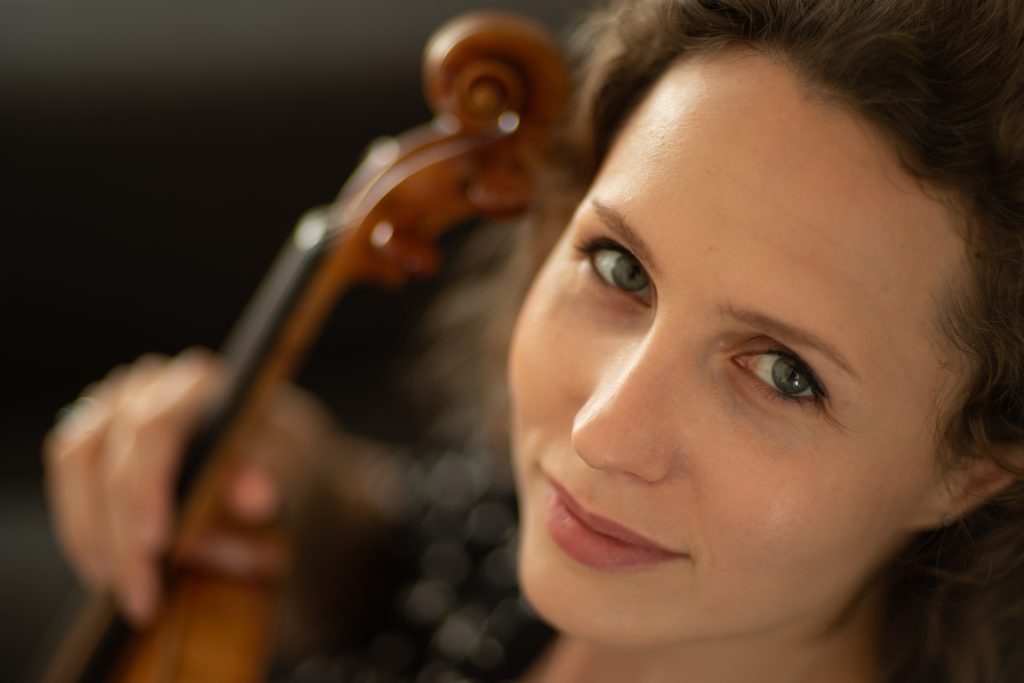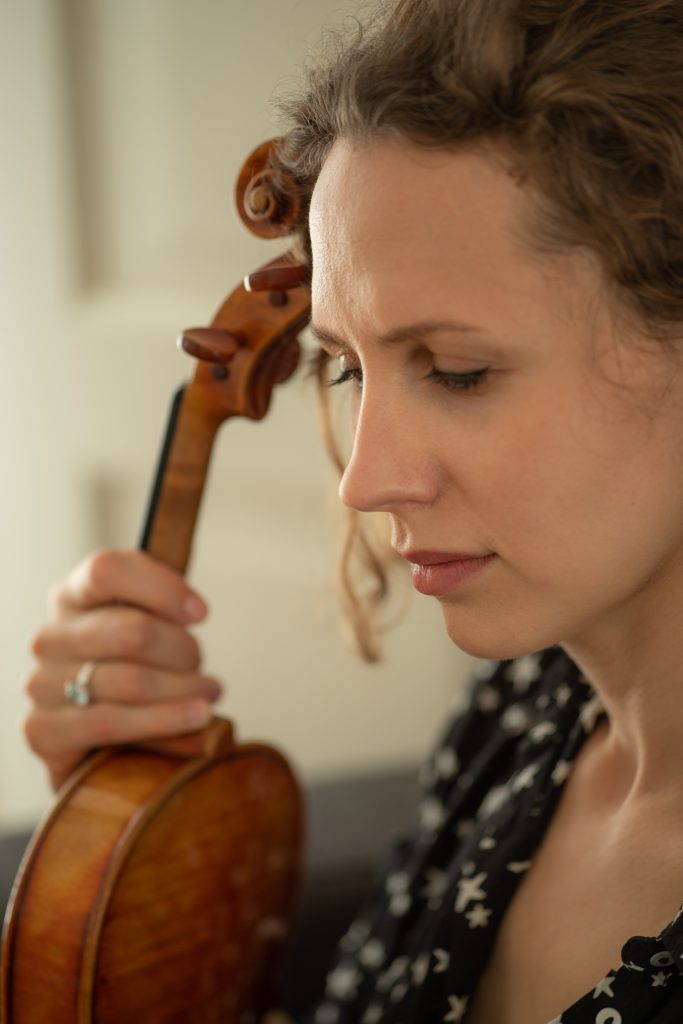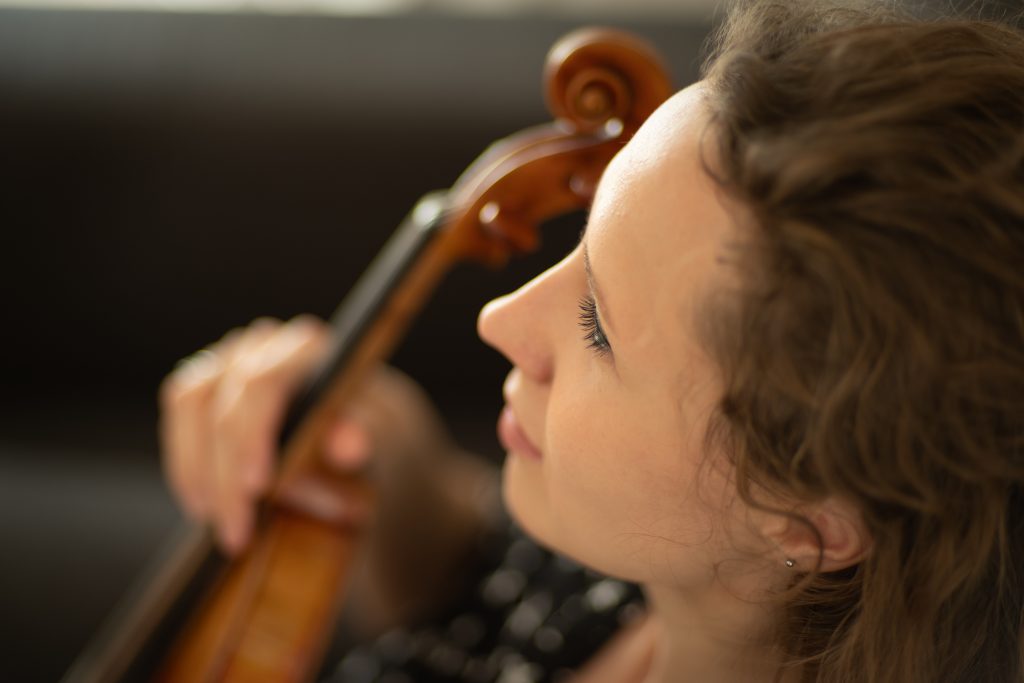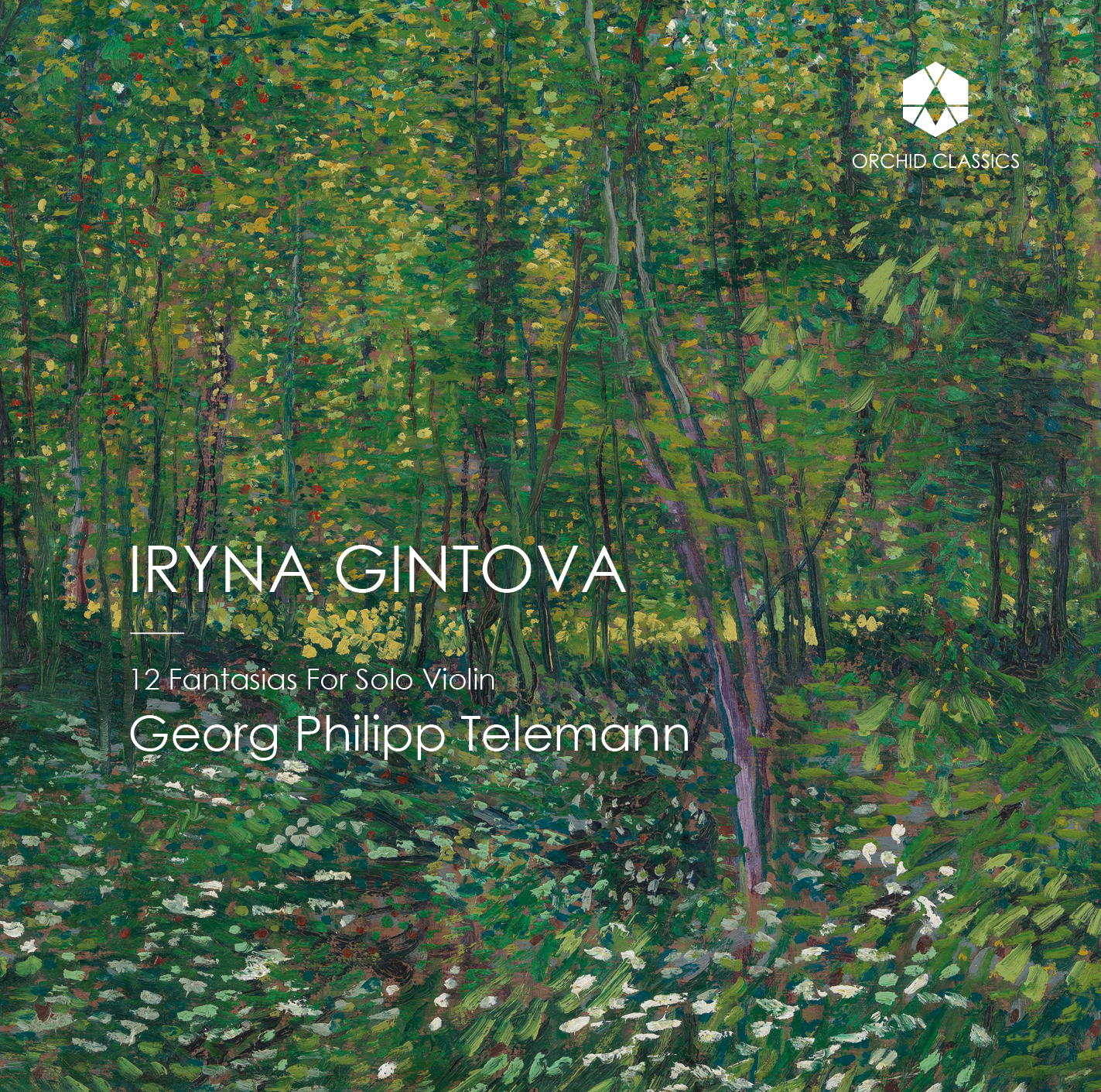Press Release
For press enquiries please contact alex.patel@orchidclassics.com. Tel: +44 7717 663481
Ukrainian violinist Iryna Gintova performs Telemann’s 12 Fantasias for solo violin, one of the pinnacles of the Baroque repertoire for the instrument.



GEORG PHILIPP TELEMANN (1681-1767)
12 Fantasias For Solo Violin, TWV 40: 14-25
Fantasia No.1 in B-flat major
1 Largo 2.19
2 Allegro – Grave – Si replica l’allegro 5.13
Fantasia No.2 in G major
3 Largo 2.07
4 Allegro 1.53
5 Allegro 0.48
Fantasia No.3 in F minor
6 Adagio 1.47
7 Presto – Grave 1.51
8 Vivace 1.09
Fantasia No.4 in D major
9 Vivace 1.41
10 Grave 0.56
11 Allegro 2.08
Fantasia No.5 in A major
12 Allegro – Presto 2.09
13 Andante 0.42
14 Allegro 2.21
Fantasia No.6 in E minor
15 Grave – Presto 3.37
16 Siciliana 1.53
17 Allegro 2.16
Fantasia No.7 in E-flat major
18 Dolce 2.28
19 Allegro 3.04
20 Largo 2.22
21 Presto 0.59
Fantasia No.8 in E major
22 Piacevolmente 2.00
23 Spirituoso 2.53
24 Allegro 0.56
Fantasia No.9 in B minor
25 Siciliana 1.43
26 Vivace 2.45
27 Allegro 1.48
Fantasia No.10 in D major
28 Presto 1.40
29 Largo 2.06
30 Allegro 0.56
Fantasia No.11 in F major
31 Un poco vivace – Soave – Da capo un poco vivace 4.37
32 Allegro 0.57
Fantasia No.12 in A minor
33 Moderato 2.41
34 Vivace – Presto 2.13
Total time 71.04
Iryna Gintova, violin
Georg Philipp Telemann (1681-1767) was one of the most prolific of all composers, producing something in the region of 6000 works. This can partly be attributed to his longevity – he died at 86, a tremendous age for the era – and to the fact that, as a child prodigy, he started writing at a very young age, producing his first opera at only 12. He also seems to have possessed an innate confidence in his own abilities, quickly outgrowing his first music lessons; he later recounted that he “had the most joyous of music trotting in my head” and that “After a calvary of 15 days, I left my teacher. And since then I have not learned a thing as far as music is concerned.”
While studying law in Leipzig, Telemann re-established the Collegium musicum (which would go on to be J.S. Bach’s trusted ensemble) and composed cantatas for the Thomaskirche. Once he had graduated, he took up positions in different regions of Germany, as well as at Sorau, in what is now Poland, absorbing different European styles in a way that belies his claim never to have learned anything about music. The court at Sorau favoured French music and Telemann inhaled scores by Lully before writing 200 French overtures in the space of two years. He then moved on to Eisenach, where he met and became great friends with Bach, and in 1721 he was appointed music director, cantor of the Johanneum and director of the Opera in Hamburg, where he established another Collegium musicum to perform his music.
By this time two important sets of music for solo violin had been issued: Johann Paul von Westhoff’s solo violin partitas of 1696, the first volume of its kind, and J.S. Bach’s seminal collection of sonatas and partitas, the Sei Solo – a violino senza Basso accompagnato, BWV 1001-1006, completed by 1720 – although it is possible that Telemann was unaware of Bach’s set when he composed his.
The ‘fantasia’, an improvisatory form, was more well established, with key precedents set by Henry Purcell in his viol works and again by Bach. Telemann seems to have favoured the form and its capacity to showcase the breadth of styles he had absorbed; he wrote 12 Fantasias for unaccompanied flute (1732-33) and 12 Fantasias each for solo violin and solo viola da gamba in 1735.
Telemann was an accomplished, self-taught violinist and seems to have relished the challenge of writing for the instrument unfortified by the usual basso continuo accompaniment. He employs techniques such as multiple stopping and implied polyphony, as used in other pivotal works of the time such as Biber’s Passacaglia (c.1676) and Bach’s Chaconne from the Partita No.2, BWV 1004. Specifically, Telemann shows his mastery of compound melodies, in which two or more voices are implied by a monodic instrument.
The other key element on which Telemann drew in these works is the art of improvisation, a crucial discipline for the performing artists of the age. The 17th-century viola da gamba player Christopher Simpson wrote guidelines for effective improvisation over a ground bass: “… you may then break into crotchets and quavers… This done, and your ground beginning over again, you may then break it into division of a quicker motion… When you have prosecuted that manner of play so long as you think fitting, and shewed some command of hand; you may then fall off to slower descant or binding-notes, as you see cause, playing also sometimes loud or soft, to express humour and draw on attention. After this you may begin to play some skipping division… or what your present fancy or invention shall prompt you to do, changing still from one variety to another; for variety it is which chiefly pleaseth.”
There is plenty of variety in Telemann’s 12 Fantasias for solo violin, which embrace a range of European styles including concerto-style movements in the manner of Corelli; Italianiate writing that contrasts with other pieces in the French style. It is possible that Telemann conceived the set as two groups of six; he referred to them as “12 fantasias … of which 6 include fugues and 6 are Galanterien”, the latter meaning movement types extraneous to the conventional suite dances of allemande, courante, sarabande and gigue, such as the minuet, bourée or gavotte. This apparent conception in two halves is borne out by the fact that the opening of the Fantasia No.7 briefly alludes to the opening of the Fantasia No.1, implying an overarching structure in two acts. Whereas the flute fantasias essentially progress through consecutive keys, the violin works are more disparate, each exploring a different aspect of the instrument’s colouristic range.
The Fantasia No.1 in B flat immediately demonstrates Telemann’s command of the idiom with a Largo in which the soloist plays an anchoring bass-line over which intricate melodic lines interspersed with double stopping create the impression of dialogue. This is followed by a spirited and demanding Allegro and mournful Grave, with a reprise of the Allegro. The Second Fantasia in G, which features rich multiple stopping, opens with a rather ambiguous Largo, its bald chords initially creating tonal uncertainty before ushering in two florid, improvisatory Allegro movements. The key of F minor seems to have inspired Telemann’s music of particular intimacy and delicacy for the Fantasia No.3, while the Fourth in D is in the Italian style with a rhythmic Vivace, a fleeting interlude in the form of the central Grave and a skipping Allegro in triple meter. The Fifth Fantasia in A contrasts older and newer, galant musical fashions, the Allegro–Presto juxtaposing the more recent emphasis on virtuoso melody with the more traditional rigours of the fugue. The Andante is another brief, rather stark, interlude, answered by a jaunty Allegro. The Fantasia No.6 in E minor emulates an Italian sonata da chiesa (church sonata) with its slow-fast-slow-fast structure, including a fugal second movement. Yet the final movement includes a tussle between E minor and E major that anticipates Classical techniques.
The Fantasia No.7 in E flat includes examples of Telemann’s enriching of the texture by breaking up the melody with the interjection of lower notes; unusually, the first movement is marked Dolce, suggesting a forward-looking, expressive approach. The Eighth Fantasia in E also includes some more rarely-used and specific markings, including the first movement, Piacevolmente (the Italian word for ‘pleasantly’) and the central Spirituoso (or Spiritoso, meaning ‘vivacious’). The Fantasia No.9 in B minor consists of three dances: a Siciliana (a slow, pastoral dance often featuring dotted rhythms), followed by a bourée (Vivace) and a gigue (Allegro). The Fantasia No.10 is, like No.4, based in the key of D – the only key heard twice in the set. The structure of the two fantasias is similar, too, with two lively outer movements framing a slow central movement, in this case a particularly plangent Largo. The penultimate Fantasia is in the pastoral key of F and includes a second movement marked Soave (‘smooth and sweet’) and a da capo third movement (a structure often used in arias, with the first section repeated). The final Fantasia is in A minor and opens with a solemn movement in the style of the French overture: in triple time and characterised by dotted rhythms. This is followed by an ornate, chromatic Vivace in the style of a gigue, and the work ends with a folk-like dance including rustic double-stopping, concluding the set in a manner that encapsulates much of the charm of these fantasias: its technical difficulty lightly worn, with an evident emphasis on giving pleasure to the listener.
© Joanna Wyld, 2021
Ukrainian violinist Iryna Gintova performs Telemann’s 12 Fantasias for solo violin, one of the pinnacles of the Baroque repertoire for the instrument.
Telemann’s 12 Fantasias embrace an array of European styles fashionable at the time, including Italianate concerto-style movements inspired by Corelli, contrasted with pieces in the French style. Telemann was an able, self-taught violinist and relished showcasing the instrument’s varied colours and techniques in these works, including multiple stopping, implied counterpoint, improvisatory lines, and tussles between traditional Baroque intricacy with newer, lighter and more forward-looking virtuoso melodies.
Iryna Gintova performs these wide-ranging works with the nuance and fluidity for which she is increasingly known in performances that have taken her to major venues, competitions and festivals around the world.
Iryna Gintova
Ukrainian violinist Iryna Gintova was born in Kyiv in 1988. At the age of 5 she began her studies at the Kyiv Central Music School under the guidance of Lyudmila Ovcharenko. When she was 9, Iryna won her first international competition in Zaporizhia, Ukraine.
Ms. Gintova currently resides in Zurich. She graduated from the Zurich University of the Arts, where she studied with Zakhar Bron and Ilya Gringolts.
Iryna has won numerous international violin competitions and awards, including the Pierre Lantier International Competition in Paris, France (2001), the Gnesin International Competition in Moscow, Russia (2003), and the “Citta di Brescia” XI International Violin Competition in Brescia, Italy (2007). She is a recipient of the Migros Culture Percentage Scholarship, Switzerland (2011).
A passionate chamber musician, has collaborated with such distinguished artists as Eldar Nebolsin, Frans Helmerson, Alexander Bonduriansky, Lawerence Power, Orfeo Mandozzi and many others.
She has performed at “Gidon Kremer’s chamber music festival in Lockenhaus” (Austria), “Herbst in der Helferei” (Switzerland), “October with great violinist” (Italy), Jeunesses Musicales International Chamber Music Campus for Ensembles (Germany) and “Encuentro de música y academia de Santander” (Spain).
Since 2013 Iryna Gintova is one of the concertmasters of Sinfonieorchester St. Gallen, Switzerland.
Ms. Gintova regularly performs solo and chamber music recitals in the major concert halls of Ukraine, Switzerland, Germany, Italy, France, and the USA.

Click the button above to download all album assets.

